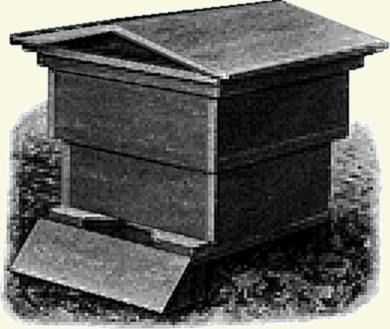
The original Dadant hive had 10 frames measuring 10½x18 inches internally that were introduced by Moses Quinby in the U.S.A, although Quinby used 11 in his hive. They were so close that even Dadant's referred to it as the Quinby-Dadant hive.
Some of the information here I have gleaned from the 1920 edition of the "Dadant System of Beekeeping" by C.P.Dadant, in which there is much discrediting of the Langstroth hive, which is smaller in volume. I suspect this is because with the smaller boxes the Langstroth was becoming more popular, therefore a threat, but this is conjecture on my part. What is certain is that Dadant's decided to redesign their hive some time prior to 1920, by copying the Langstroth frame top bar length of 19 inches, some 1⅛ inches shorter, though the same depth, 2⅛ inches deeper than the Langstroth. This hive they called the "Modified Dadant" (commonly referred to as "MD") in the U.S. and the U.K. and the "Dadant-Blatt" in continental Europe. I am unaware of where the "Blatt" came from. Dadant's recommended a minimum of 10 frames, but most have settled on 11
In researching for this page I have found considerable local variation, perhaps by copying hive parts that may have become distorted or by metricating imperial measurements. The Dadant-Blatt has a lot of variation with both 10 and 12 frame versions, where the MD has 11!
The Buckfast Dadant is a twelve frame version that has a square body. These are mainly found in areas that are close to Buckfast Abbey or in places where Bro. Adam's followers have gathered into groups.
A websearch gives much conflicting information, especially on sizes. I don't know where Dave Cushman found the picture on the right but it seems fairly certain to be an original Dadant hive as mentioned above.There is a photograph of one remarkably similar alongside an 8 frame Langstroth in Fig.9. Page 12 of the 1920 edition of the "Dadant System of Beekeeping".
These hives are the largest in common use and in my opinion are far too big for beekeeping in the U.K. unless very prolific bees are kept. Certainly all of my colonies would be lost in them! A look at the websites of U.S. bee equipment suppliers suggests that few are stocked now.
There are dimensional and construction details here for U.K. Dadant hives. This information is by kind permission of the Scottish Beekeepers Ass'n.
Originally written by Dave Cushman. Rewritten by Roger Patterson.
Page created pre-2011
Page updated 03/12/2022